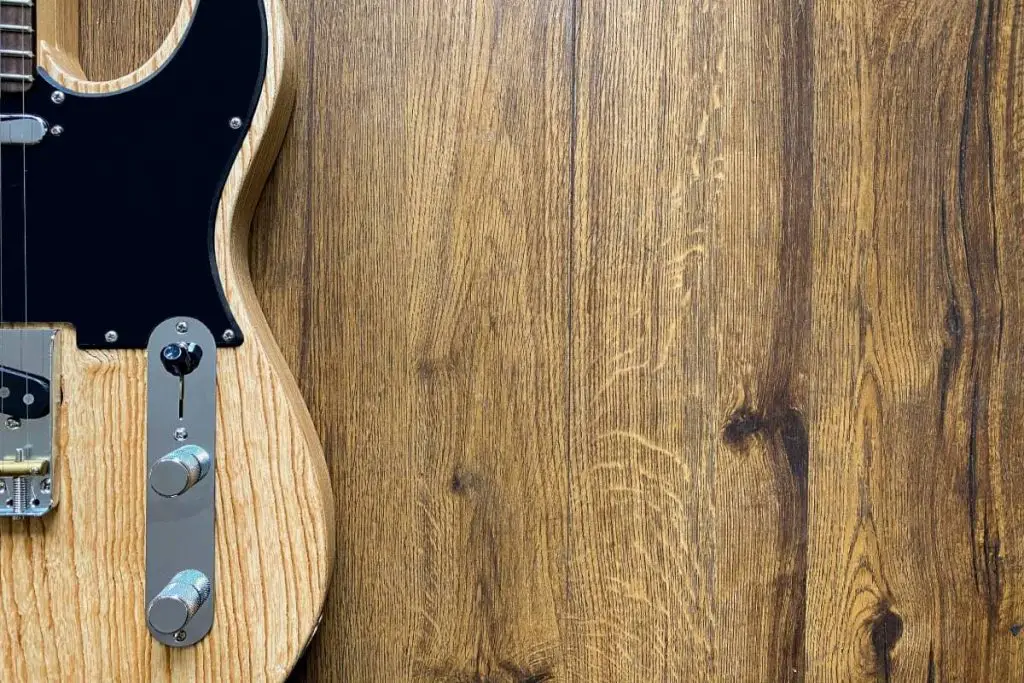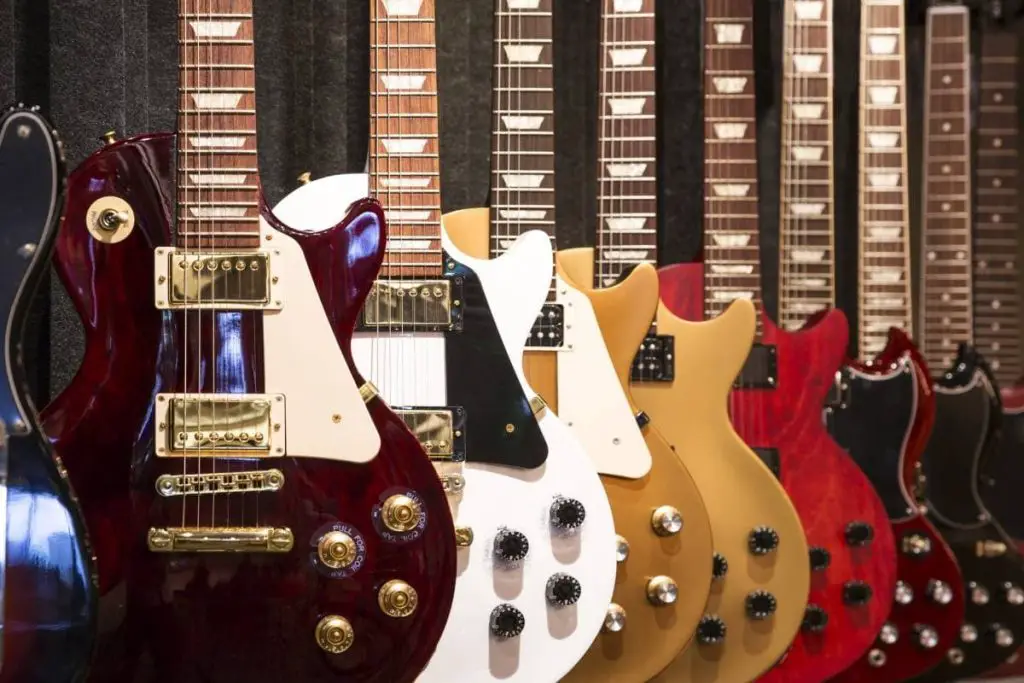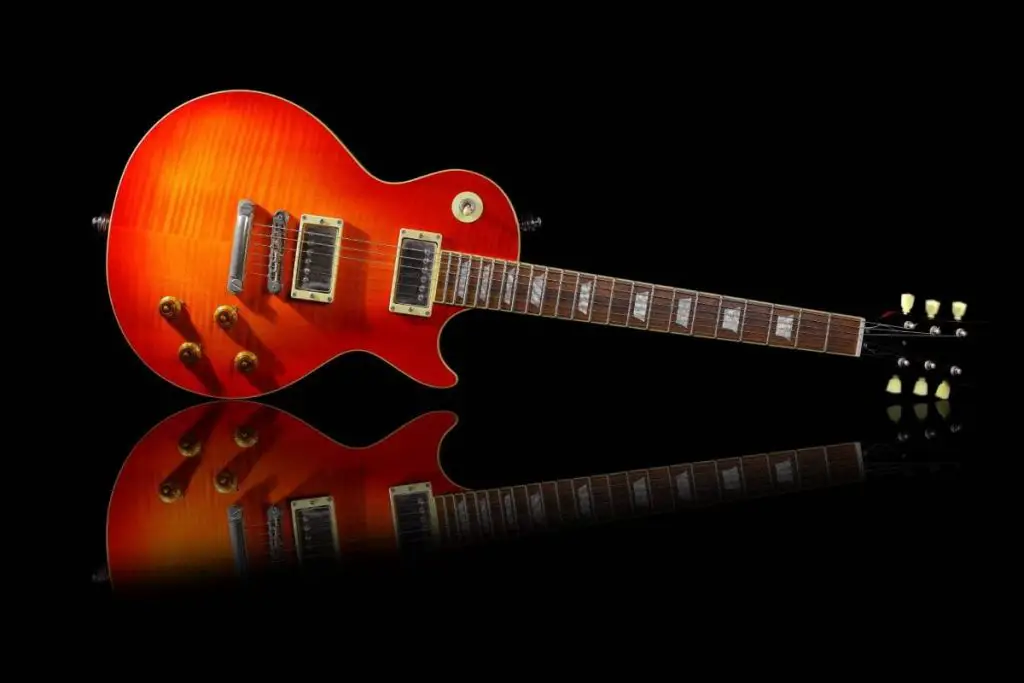Electric guitars can often range in price, but the average guitar will set you back $600-$900. This is not an affordable price tag, and with entry-level acoustic guitars falling in the $100-$200 price range, it may be confusing to some why electric guitars are so much more expensive. There are many facets that go into producing an electric guitar that drives up the cost.
Here are seven reasons why electric guitars are so expensive:
- Electric guitars take a long time to make.
- The guitar has gone through extensive quality control.
- Expensive guitars use high-quality wood.
- Brand appeal allows some companies to charge more.
- The guitar was manufactured in Europe, the US, or Japan.
- The guitar is made of high-quality materials.
- The instrument is aesthetically pleasing.
Let’s take a closer look at each of these reasons so you’ll have a better understanding of why you’re dropping nearly a grand or more on an electric guitar.
👇😀👇NOTE👇😀👇
If you want to find out what my recommended guitar gear is, then here is what I recommend on Amazon:
- Fender Cutaway Acoustic-Electric Guitar Bundle (MY FAVORITE GUITAR)
- Snark SN-8 Super Tight All Instrument Tuner (Easiest Tuner I’ve Used😏)
- 6 String Acoustic Guitar Capo (Best CAPO for quick changes)
- Dunlop Max Grip 1.0mm Nylon Picks (Thick Guitar Pick So You Don’t Lose Grip!)
- Universal Guitar Stand (Cheap & Minimalist Guitar Stand I Recommend)
- Levy’s 2″ Wide Quick Adjust Guitar Strap (Best Guitar Strap For Any Level)

1. Electric Guitars Take a Long Time To Make
Making an electric guitar requires skilled labor, which comes at a cost. It can take up to 200 hours of hard work to make one of these instruments, and if the laborers are paid fairly, this will increase the price of the final product.
However, thanks to modern technology, the process doesn’t always take that long. Machines can speed up parts of the process, and some electric guitars are made entirely by factory equipment. These guitars will be less expensive, but they may also suffer from some errors in the manufacturing process if the company didn’t do a thorough quality check.
If you would like an electric guitar made by someone who truly understands everything that makes a great guitar and is checking the quality every step of the way, you’re going to have to be prepared to pay for the time that this kind of guitar manufacturing takes. I recommend going this route if you can afford the hefty price tag. There’s something special about knowing that your instrument was made entirely with someone’s hands and not by a factory machine.
2. The Guitar Has Gone Through Extensive Quality Control
Electric guitars are complicated instruments; in many cases, different parts of the guitar were assembled by different people. Therefore, the instrument has to undergo an extensive quality control procedure to ensure everything was put together properly and works as it should.
Some companies rush through this process or don’t employ highly skilled workers to keep the costs down. This results in a less expensive guitar and a guitar that may have issues that will impact your ability to play and enjoy the instrument. You may end up paying more to get it fixed than you would’ve had you sprung for a more expensive model initially.
More expensive guitars usually come from companies with thorough quality control procedures sure to catch every mistake, if there is one.
A good quality control check should also include a complete setup. A setup is a series of adjustments that ensure the guitar is ready to play immediately upon purchase. A setup includes:
- Adjusting the truss rod to achieve a straight neck.
- Adjusting the bridge.
- Checking the nut and eliminating any fret buzz.
- Tuning the guitar to standard tuning.
- Inotating the guitar.
- Buffing and polishing the exterior.
- Checking the exterior for blemishes in the wood.
- Ensuring that the electronics work as they should.
Sufficient quality control requires experienced and skilled workers with an eye for detail. It costs companies more to pay these sought-after workers fairly, which will reflect in the cost of the final instrument.

3. Expensive Guitars Use High-Quality Wood
Electric guitars can be made of various types of wood, and different wood species vary in value depending on the rarity and accessibility.
The body, neck, and fretboard of electric guitars are made from wood, and the type of wood used greatly influences how the guitar sounds. The varying grains, gaps, and other qualities in the wood affect the vibrations when you strum the strings, making each instrument unique.
Some wood varieties are now protected for environmental reasons. This is why an electric guitar made of Brazilian Rosewood is one of the most expensive kinds of guitar you can buy; this wood is now completely illegal to harvest, and any guitar made of the wood must be accompanied by paperwork that proves the wood was harvested before the ban was placed.
Because no new guitars can be made of this wood, a Brazilian Rosewood guitar costs at least $10,000 and even as much as $30,000. Luckily, there are less expensive materials that you can opt for that won’t bankrupt you.
Here are the wood species that are commonly used in guitar construction:
- Maple: Maple is a hardwood that makes for good sustain. Guitar manufacturers use maple for the neck of guitars because it is a strong wood that can survive the strain of the guitar strings. It is a less expensive variety because it is mostly harvested in the United States and Canada instead of overseas, so the manufacturer doesn’t have to pay as much for transport.
- Basswood: Basswood results in a warm, balanced sound and is a favorite of guitar manufacturers because it is easy to work with. It is also one of the cheaper woods to use for a guitar. However, high-end manufacturers inculcate the material, so it sounds great and lasts longer.
- Alder: Many more expensive guitars use Alder because it is lightweight, has unique and beautiful grain patterns, and provides a great, full-bodied sound. Most Fender guitars from the 1950s and 1960s are made of Alder.
- Ash: Ash boasts many similar features to Alder. Swamp ash is light and has grain patterns that look beautiful under a translucent finish, and it creates airy and pleasant high sounds.
- Mahogany: This is a classic wood variety for use in guitar necks. It is a dense material that produces a warm and deep sound.
- Rosewood: This highly-priced tonewood is often used in fretboards, and guitars made with this material are usually heavy and expensive.
- Korina: Korina creates a clear, resonant, and sustainable sound that high-end manufacturers, including Gibson, use regularly.
- Poplar: Asian-made electric guitars often use this soft hardwood in the body. It is a cheaper wood that produces sonically balanced but bland sound.
- Walnut: This heavy wood is similar to mahogany in sound quality. It is also aesthetically pleasing, with rich brown color and pleasing grain patterns that look nice under simple, translucent coats.
An electric guitar made from cheaper wood doesn’t necessarily mean that it is a bad instrument, especially if it comes from a high-end guitar maker. Many people use and enjoy these guitars for years without any problems. However, if you want an electric guitar that looks and sounds amazing, you’ll probably have to pay for a more expensive wood variety, such as Alder.

4. Brand Appeal Allows Some Companies To Charge More
Some brands have a certain appeal, quality, or history that allows them to charge more for their guitars because they will have their brand name on them. Just like in fashion, where certain brands like Louis Vuitton, Chanel, and Prada can charge more for their items simply because of their reputation and status in the fashion community, certain guitar brands can charge more because of who they are.
Fender and Gibson have been around since the birth of electric guitars and are now considered iconic brands for which people are willing to shell out some major dough. Furthermore, some of the most famous musicians in history have used guitars by these brands, so people who idolize these guitarists will likely pay more for a guitar similar to the one their musical hero played.
For example, these famous musicians have all used the Fender Stratocaster at some point:
- Jeff Beck: Jeff Beck had great solo success, but he also played with The Yardbirds and the Jeff Beck Group and on albums by Mick Jagger, Jon Bon Jovi, and Stevie Wonder. He is most known for his versatility: he plays blues, rock, jazz, metal, and electronica.
- Eric Clapton: Clapton is known as one of the most successful guitarists in rock. In the 1970s, he bought six Fender Stratocasters, gave three of them away, and kept the other three for himself. Using different parts from all three, he made “Blackie,” a guitar he used for twelve years.
- George Harrison: Harrison said his Stratocaster was one of his favorite guitars throughout his career. He used it for the Beatles: Help!, Rubber Soul, Revolver, Sgt. Pepper’s Lonely Hearts Club Band, and Magical Mystery Tour.
- Jimi Hendrix: Many consider Hendrix to be the greatest guitarist of all time. He used many Stratocasters throughout his career.
- Buddy Holly: Buddy Holly was one of the first musicians to play the Stratocaster to mass audiences, and they loved it. He influenced the musical stylings of the Beatles and Bruce Springsteen.
- Rory Gallagher: Sometimes referred to as “the greatest guitarist you’ve never heard of,” this Irish guitarist is associated with his 1961 Stratocaster and his improvisational solos inspired by jazz saxophone players.
- Albert Hammond Jr: As guitarist for The Strokes, Albert Hammond Jr. is one of the most influential guitarists of the 21st century. He played an all-white Stratocaster that contributed to the band’s retro vibe.
- David Gilmour: The singer and guitarist for Pink Floyd has also achieved solo success. He’s also the mastermind behind some of the most famous guitar solos of all time, including “Comfortably Numb,” for which he used his Stratocaster.
Who wouldn’t want to get their hands on the same guitar brand as Jimi Hendrix?
Gibson has a similarly impressive reputation. The following musicians helped put this brand on the map:
- BB King: The King is credited with inventing guitar solos that use vibrato and string bends. He named all his guitars Lucille, and because of this, Gibson has a model called “Lucille” to this day.
- Elvis Presley: Elvis Presley is an icon in pop culture and is known for his wiggly dance moves and his hit songs, including “Heartbreak Hotel.” Hits like that led him to become one of the best-selling solo artists in history. He also favored Gibson electric guitars, which is a pretty good endorsement for the brand.
- Angus Young: As lead guitarist for AC/DC, Young is known for some of music’s most famous riffs, including the unforgettable “Highway to Hell.” The band is still prominent today, and Young still uses a Gibson.
- Slash: Guitarist for the Guns N’ Roses, Slash, is a celebrated guitarist known for blues-style solos. In their iconic music videos, he can be seen playing his Gibson Les Paul. He is also the first global brand ambassador for Gibson.
- Jimmy Page: Led Zeppelin guitarist Jimmy Page used a double-neck Gibson and a Gibson Les Paul, and he’s responsible for one of the most iconic guitar solos: “Stairway to Heaven.”
- Billy Gibbons: ZZ Top frontman and guitarist Billy Gibbons bought a 1959 Gibson Les Paul with the money he got from selling an old car and named it Pearly Gates, after the sold car. He still uses it.
- Neal Schon: As guitarist for Journey, Schon uses his Gibson to produce memorable riffs and solos.
Because of their history and status, Fender and Gibson can charge more than their competitors and still have a clientele willing to pay more. Fender guitars range in price from $600 to $3,500, and Gibson’s Original Collection ranges from $1,500 to $4,000.
Another brand that doesn’t have the historical significance of Fender and Gibson but still has brand appeal is PRS Main. PRS has a good reputation because they only produce high-end guitars made with the best materials.

5. The Guitar Was Manufactured in Europe, the US, or Japan
Different countries have various fixed costs that influence a product’s final price. It costs more to manufacture guitars in Europe, the United States, and Japan than it does to have a guitar made in China, Korea, or Indonesia.
This is not to say that all guitars made in China are cheap and low-quality. However, making guitars there costs less because of labor laws in China. Therefore, companies prioritizing keeping their costs down will have their guitars made in China in large factories instead of in Japan or the United States.
The following table outlines popular countries where guitars are made and the brands that have their guitars manufactured there:
| Country | Brands |
| The United States | Fender Gibson PRS G&L Guitars Heritage Guitar Inc. Kurt Wilson Jon Kammerer |
| China | Epiphone Washburn Yamaha Guild Eastman Ovation BlueridgeAlvarez Luna Sigma |
| Mexico | Fender (low-end guitars in the Player series) Taylor |
| Indonesia | Jackson Yamaha Schecter |
| Korea | PRS (entry-level guitars in the SE line) SquierEpiphone Martin Cort CJ |
| Japan | Ibanez Yamaha ESP Takamine |
| Germany | Hofner Framus Huttl Hoyer GuitarsDuesenberg |
| United Kingdom | Orange Vox Gordon Smith TanglewoodBrian May Guitars |
Countries that pay their workers fair wages, conduct thorough quality control checks, and use high-quality materials will always charge more to make guitars. Then, as the consumer, you will have to make up for this cost by paying more for the instrument.
6. The Guitar Is Made of High-Quality Materials
Electric guitars are made primarily of wood, but there’s a wide array of other materials used for some parts and details. There are different levels of hardware quality that impact the cost of the final product.
Let’s take a look at the different hardware pieces on an electric guitar that influence the price:
- Tuners: Tuners are not the most expensive element on an electric guitar, but a low-end guitar will have tuners that get stuck or don’t hold a tune. Tuners made with a stronger material will not fail under the strain of the strings and will hold a tune for longer.
- Bridge: Cheap bridges have sharp saddles that can cause string breakage, whereas higher-quality bridges don’t experience this issue.
- Pickups: This is perhaps the trickiest part of an electric guitar to get right. A pickup is made of a copper wire wound over magnetic poles thousands of times, and the quality of all these components influences how the guitar sounds. A cheap pickup will cause an annoying buzz or uneven volume.
High-end guitar brands ensure that special care and attention is given, all of these pieces are made of high-quality, long-lasting materials, and that everything is installed properly.

7. The Instrument Is Aesthetically Pleasing
Let’s face it: when it comes to guitars, looks do matter. Guitars should look cool! Cheap guitars can copy the design of their costlier counterparts, but to get a lower price, they’ll have to use cheaper wood, paint, and lacquer. The end result just doesn’t look the same as a higher-end guitar that spared no expense to make the guitar look the best it can.
Furthermore, if you want a signature guitar with unique or personalized artwork, this will greatly increase the price. A custom guitar is truly a work of art, both sonically and visually, but it will cost a pretty penny.
Furthermore, some aesthetically-pleasing electric guitar designs require more handwork and attention to detail than others, which results in higher labor costs.
👇😀👇NOTE👇😀👇
If you want to find out what my recommended guitar gear is, then here is what I recommend on Amazon:
- Fender Cutaway Acoustic-Electric Guitar Bundle (MY FAVORITE GUITAR)
- Snark SN-8 Super Tight All Instrument Tuner (Easiest Tuner I’ve Used😏)
- 6 String Acoustic Guitar Capo (Best CAPO for quick changes)
- Dunlop Max Grip 1.0mm Nylon Picks (Thick Guitar Pick So You Don’t Lose Grip!)
- Universal Guitar Stand (Cheap & Minimalist Guitar Stand I Recommend)
- Levy’s 2″ Wide Quick Adjust Guitar Strap (Best Guitar Strap For Any Level)
Related Posts:

